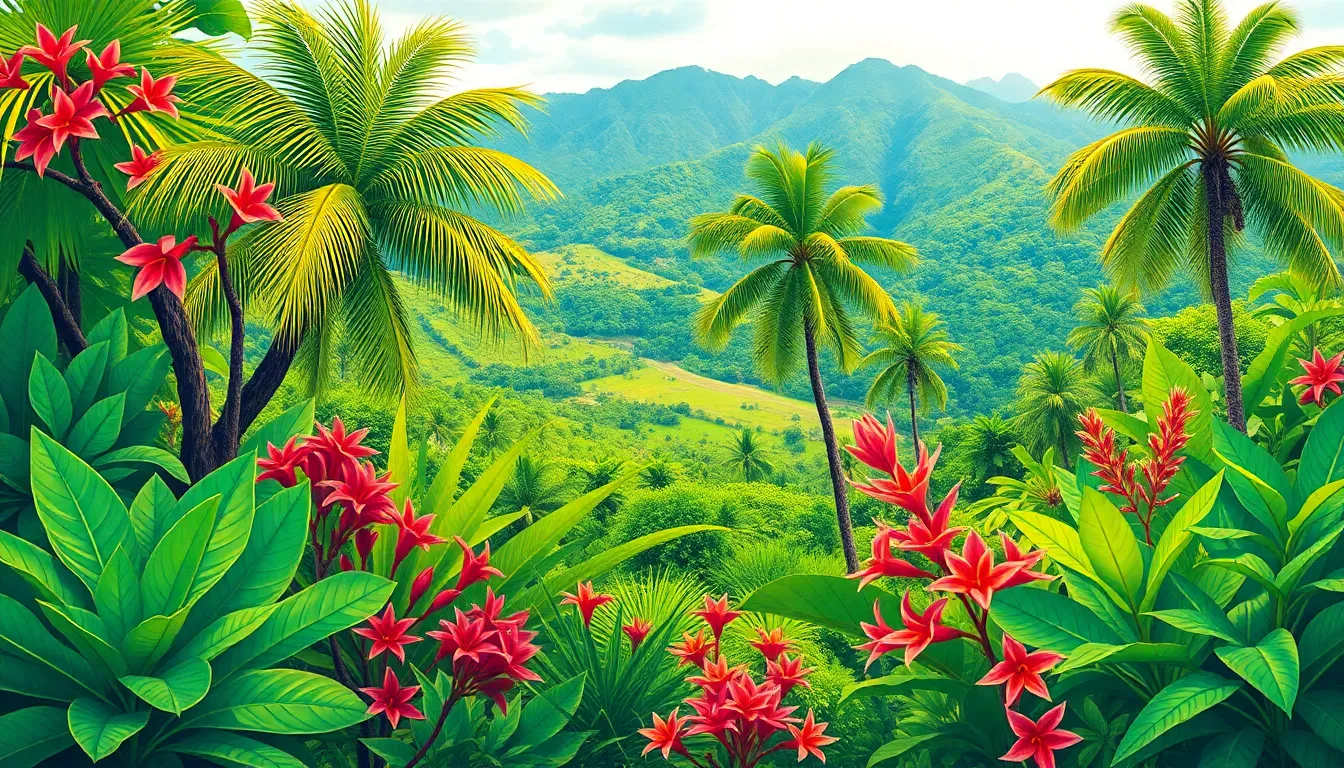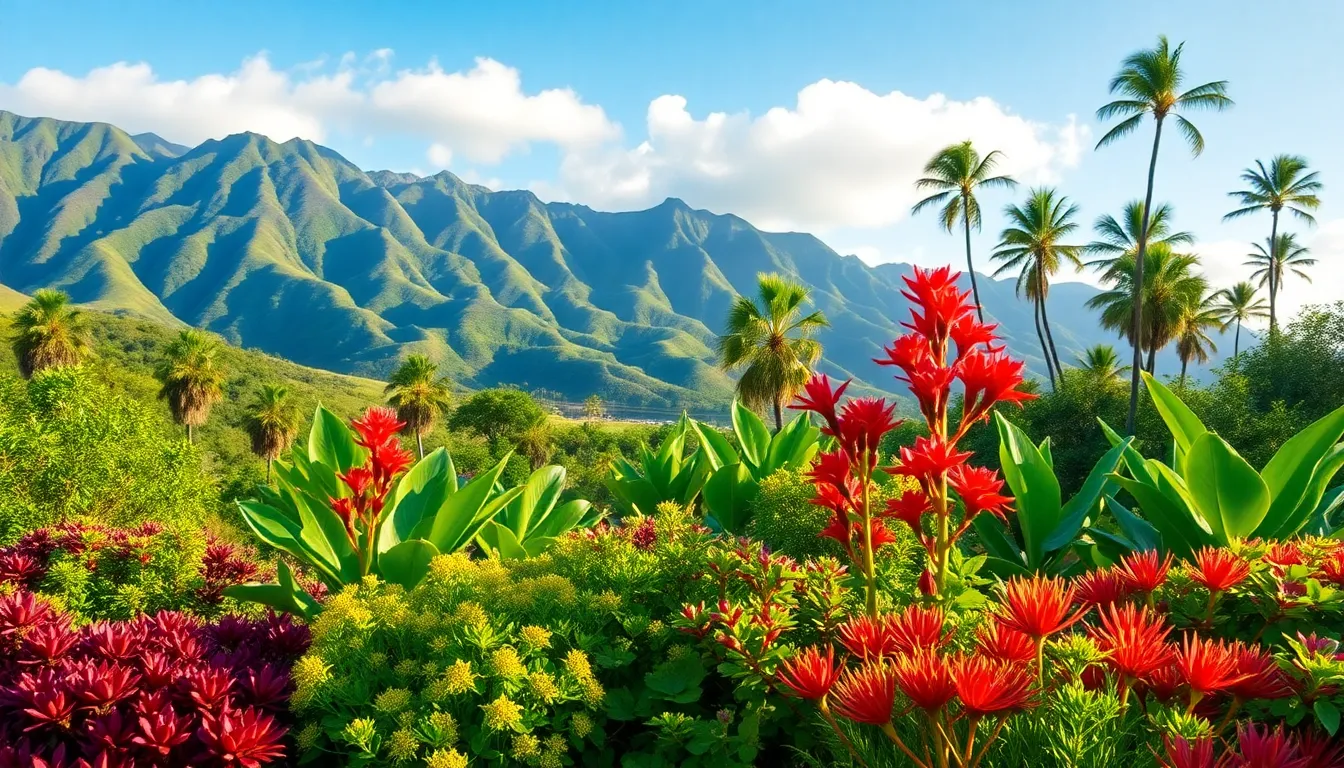Hawaii isn’t just a paradise for sun-seekers and surfers; it’s also a botanical wonderland bursting with unique native plants. Imagine lush landscapes where vibrant flowers and towering trees create a natural tapestry that’s as diverse as the islands themselves. These plants aren’t just pretty faces; they play crucial roles in the ecosystem, supporting wildlife and preserving the cultural heritage of Hawaii.
Hawaii Native Plants
Hawaii’s native plants form a crucial component of its unique ecosystem. These plants evolved in isolation for millions of years, leading to the formation of diverse species. Around 90 percent of the flowering plants in Hawaii are endemic, meaning they exist nowhere else in the world.
Significant examples include the ‘Ōhi’a Lehua (Metrosideros polymorpha), which plays a vital role in many Hawaiian ecosystems. This plant produces stunning red flowers and serves as a primary food source for native birds such as the Hawaiian honeycreeper. Additionally, Koa trees (Acacia koa) contribute to forest stability and provide habitat for numerous species.
Hawaii’s ecosystem relies on these native plants for carbon sequestration and soil stabilization. Through their unique adaptations, they thrive in various environments, from coastal areas to mountainous regions. Plants like the Nene (Branta sandvicensis) use the vegetation in their habitats for nesting and foraging.
Culturally, native plants hold great significance in Hawaiian traditions. They are integral to practices such as hula and lei-making, emphasizing connection to the land. Efforts are underway to conserve and restore these native species, emphasizing their ecological and cultural importance while combating invasive species.
Understanding Hawaii’s native flora helps in appreciating the islands’ unique landscapes. Preservation initiatives focus on habitats, supporting the growth of both native plants and wildlife. Protecting these species ensures the continuation of both biodiversity and cultural heritage for future generations.
Importance of Hawaii Native Plants

Hawaii’s native plants play a crucial role in maintaining the islands’ delicate ecosystems and cultural identity.
Ecological Benefits
These plants contribute significantly to biodiversity. They provide essential habitat and food sources for various species, including many native birds. Approximately 90 percent of flowering plants in Hawaii are endemic, which means they exist nowhere else. Unique species like ‘Ōhi’a Lehua support pollinators, while Koa trees enhance forest stability and resilience. Additionally, native flora aids in carbon sequestration and soil stabilization, promoting healthy ecosystems. Their adaptation to local conditions enables them to thrive across diverse environments. Invasive species threaten these vital plants, which is why ongoing conservation efforts focus on protecting their habitats.
Cultural Significance
Cultural practices in Hawaii are deeply intertwined with native plants. For instance, plants are integral to traditional arts such as hula and lei-making. Specific species hold spiritual significance, embodying health and beauty through customs and rituals. Through storytelling and song, these plants are prominent symbols of Hawaiian identity. Families often pass down knowledge about their uses, highlighting their roles in ceremonies and daily life. This connection fosters a sense of community and identity, reinforcing the importance of preserving native flora for future generations.
Common Hawaii Native Plants
Hawaii boasts a variety of native plants, each contributing significantly to its unique biodiversity and cultural heritage.
Trees and Shrubs
‘Ōhi’a Lehua stands out among Hawaii’s native trees due to its bright red flowers and crucial role in supporting Hawaii’s unique wildlife. Koa trees also feature prominently, providing habitats for various species while enhancing forest architecture. They grow tall, boasting strong wood that has traditional uses in Hawaiian culture. Nanu (Hawaiian snow) adds diversity with its adaptability to various environments, enriching the understory greenery. Another noteworthy species includes the Lama tree, known for its distinctive leaves and valuable wood, often used in traditional applications. Each tree and shrub plays a role in stabilizing the ecosystem, contributing to soil health and carbon sequestration.
Groundcovers and Vines
Hawaiian native plants also include various groundcovers and vines that thrive in the unique climate. The native Pili grass is resilient, commonly used in traditional practices to control erosion and promote soil health. ‘Ahu’awa, a sedge, grows in wetlands and marshes, providing habitat for native wildlife and helping to filter water. Another essential groundcover is the ‘Ilima, which produces beautiful yellow-orange flowers and holds cultural significance in lei-making. Vines such as the Hawaiian passionflower enhance the ecosystem, attracting pollinators with their striking blooms. Each of these plants collectively strengthens the landscape, ensuring the biodiversity of Hawaii thrives.
Threats to Hawaii Native Plants
Hawaii’s native plants face significant threats that jeopardize their survival. These threats stem from both invasive species and climate change, impacting ecosystems and biodiversity.
Invasive Species
Invasive species pose a major risk to Hawaii’s native plants. Non-native plants like guava and monkeypod dominate landscapes, outcompeting native flora for resources. Animals such as rats, pigs, and goats disrupt habitats by feeding on native plants and their seeds. The introduction of invasive insects further exacerbates the situation, leading to increased disease and decline among indigenous species. Estimates indicate that approximately 25 percent of Hawaii’s native plants are now endangered due to these threats. Addressing invasive species requires focused management efforts to restore balance in Hawaii’s ecosystems.
Climate Change
Climate change creates additional challenges for Hawaii’s native plants. Rising temperatures and changing precipitation patterns affect growth and survival rates. Increased frequency of extreme weather events threatens the stability of habitats. Sea level rise poses a risk to coastal ecosystems, impacting native plant communities. Data suggests that up to 75 percent of Hawaii’s native plants face heightened vulnerability due to climate change effects. Conservation strategies must adapt to these evolving conditions to safeguard the biodiversity of Hawaii’s unique ecosystems.
Conservation Efforts for Hawaii Native Plants
Organizations and communities actively protect Hawaii’s native plants from threats. The Hawaii Department of Land and Natural Resources implements strategies for habitat restoration. Various projects focus on removing invasive species that disrupt native ecosystems and threaten biodiversity.
Scientists conduct research to monitor the health of endangered species. Collaborative efforts between federal, state, and local agencies ensure resources are allocated effectively. Education programs engage the public, raising awareness about the importance of native flora.
Seeds from endangered plants are collected and stored in seed banks for future restoration efforts. Organizations like the National Tropical Botanical Garden and The Nature Conservancy implement conservation programs that focus on sustainable management and land preservation.
Restoration sites often feature native plants that improve soil health and prevent erosion. Community planting events invite local residents to get involved, creating a sense of ownership and fostering cultural connections. Traditional knowledge shared by Native Hawaiians enhances conservation practices, ensuring approaches respect cultural heritage.
Monitoring threats remains a priority, especially with invasive species like guava and rats that outcompete native plants. Adjustments to conservation tactics are necessary as climate change influences plant growth and habitat suitability across the islands. As a result, adaptive management strategies help mitigate these constantly evolving challenges.
Resource allocation for conservation efforts contributes to the preservation of Hawaii’s biodiversity, ensuring native plants thrive. Community engagement and scientific research work hand in hand, fostering a collaborative approach to safeguard these unique ecosystems. Saving Hawaii’s native plants reflects a commitment to protecting the islands’ rich cultural and ecological heritage for future generations.
Conclusion
Hawaii’s native plants are not just beautiful; they are essential to the islands’ ecosystems and cultural identity. Their unique adaptations and roles in supporting wildlife highlight the intricate balance of Hawaii’s natural world. The ongoing conservation efforts reflect a collective commitment to preserving this botanical treasure for future generations. By fostering community involvement and respecting traditional knowledge, there’s hope for the survival of these endemic species. Protecting Hawaii’s native flora is crucial not only for biodiversity but also for maintaining the rich cultural heritage that these plants embody. As awareness grows, so does the potential for a sustainable future where Hawaii’s unique landscapes thrive.

